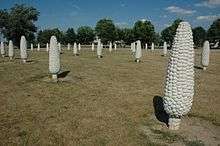Field of Corn

Field of Corn (with Osage Orange Trees) is a publicly funded art installation in the city of Dublin, Ohio. The installation consists of 109 concrete ears of corn positioned in rows and standing upright in a grassy field. At one end of the field are two rows of Osage-orange trees, one pre-existing and the other planted for the project. Sculpted by Malcolm Cochran[1] and with landscaping by Stephen Drown and James Hiss, the field of corn was commissioned by the Dublin Arts Council and completed in 1994.[2]
The display site, named the Sam and Eulalia Frantz Park, was originally farmed by Sam Frantz, an inventor of several hybrid corn species, and was donated to the city in the late twentieth century. The art installation is partly a tribute to Sam Frantz and is also intended to remind visitors of Dublin's agricultural heritage. Along the west side of the park, near the Osage orange trees, are signs that describe the project and explain hybridization.[3]
Three different molds were used to cast the concrete ears of corn, which stand about 8 feet (2 m) tall. The breed of corn represented is known as Corn Belt Dent Corn, a double-cross hybrid variety. The ears are rotated in several directions to make it appear as if each ear is unique. They were cast at a precast concrete manufacturer, Cook & Ingle Co., in Dalton, Georgia.[4] Each ear weighs 1,500 lb (680 kg)[5]
Soon after completion, the Field of Corn became a joke as it portrayed giant inedible food and was paid for with tax dollars. Locals colloquially call the site "Cornhenge" due to its vague resemblance to the prehistoric Stonehenge monument. The site is surrounded by a sprawl of corporate offices, bland businesses and suburban neighborhoods making it an odd but interesting sight that attracts some tourism. [6] As for the public backlash, Dublin Arts Council Executive Director David Guion isn’t too concerned. "Public art should inspire an emotional response", he says. "And Field of Corn has done just that." [5]
References
- ↑ Raskin, David (May 2000). "Malcolm Cochran at the Cleveland Center for Contemporary Art". Art in America. 88 (5): 171.
- ↑ Krug, Don. "Ecological Design: Malcolm Cochran, Field of Corn (with Osage Orange)". Art & Ecology: Perspectives and Issues.
- ↑ Hurd, Mary K. (1995). "Artist Chooses Precast Concrete for Field of Corn" (PDF): 30–3.
- ↑ Hurd, Mary K. (1995). "Artist Chooses Precast Concrete for Field of Corn" (PDF): 30–3.
- 1 2 "field of corn (with osage oranges)". Dublin Arts Council.
- ↑ Road Side America
Further reading
- Twilley, Nicola (February 10, 2011). "Feast Your Eyes: The Concrete Corn Field of Dublin, Ohio". Good.
- Buchanan, Doug (October 5, 2012). "Field of Corn in Dublin under wraps while undergoing restoration". Columbus Business First.
- "Field of Corn". Ohio Outdoor Sculpture Inventory.
- Zurcher, Neil (2008). "More Big Ears". Ohio Oddities: A Guide to the Curious Attractions of the Buckeye State. pp. 15–6. ISBN 978-1-59851-047-8.
- Hurd, Mary K. (1995). "Artist Chooses Precast Concrete for Field of Corn" (PDF): 30–3.
- Koroscik, Judith Smith (Spring 1995). "Guest Editorial: Letters to the Editor: The Public's Disclosure of How They Understand the Arts". Studies in Art Education. 36 (3): 131–3. JSTOR 1320904.
- Hogue, Beverly J. (2008). "From Mulberries to Machines: Planting the Simulated Garden". Interdisciplinary Studies in Literature and Environment. 15 (1): 101–10. doi:10.1093/isle/15.1.101.
- Argiro, Carol (July 2004). "Instructional Resources: Teaching with Public Art". Art Education. 57 (4): 25–32. JSTOR 3194122.
Coordinates: 40°5′6″N 83°7′24″W / 40.08500°N 83.12333°W